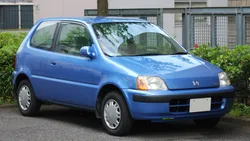

Honda Logo Generation 1 Facelift 2000 Overview
Explore the Honda Logo generation 1 facelift 2000 model, including its unique features and specifications. Discover why this model stands out in Portugal's automotive market.
The Honda Logo Generation 1, with its facelift in 2000, marked an important milestone in the history of Honda's compact urban cars. Known for its reliability and fuel efficiency, the Hond...
Technical Specifications
Select Version
Dimensions
Engine
Driving
Others
History and Features
Mycarro AI
Feb 1, 2024
Introduction
The Honda Logo Generation 1, with its facelift in 2000, marked an important milestone in the history of Honda's compact urban cars. Known for its reliability and fuel efficiency, the Honda Logo has been a popular choice for city drivers since its introduction in 1996. The Generation 1 facelift captured the essence of Honda's commitment to constant improvement and innovation, with notable upgrades in both aesthetics and performance.
Exterior Design
With the facelift in 2000, the Honda Logo Generation 1 received a refreshed exterior design that brought a more modern and dynamic look to the car. The front grille was restyled with a sleeker appearance, complemented by new headlights and fog lights that enhanced visibility. The rounded shape of the car was retained, but with sharper lines and smoother curves, giving it a more contemporary appeal. The facelift also introduced new alloy wheel designs, further enhancing the Logo's sporty and stylish appearance.
Interior Comfort and Features
Inside the Honda Logo Generation 1, the facelift introduced several upgrades to enhance comfort and convenience. The cabin featured improved seat materials and additional padding, offering better support during long drives. The dashboard was redesigned with a more ergonomic layout, placing controls within easy reach of the driver. The facelift also saw the introduction of new features, such as power windows, central locking, and air conditioning, elevating the overall driving experience.
Performance and Engine
Under the hood, the Honda Logo Generation 1 (facelift 2000) offered improved performance and efficiency. The 1.3-liter engine was tweaked to deliver more power while maintaining its renowned fuel economy. With responsive acceleration and smooth handling, the Logo was an agile car, well-suited for navigating crowded city streets. The facelift also included updates to the suspension system, resulting in a comfortable and stable ride, even on rough road surfaces.
Safety and Technology
In terms of safety, the Honda Logo Generation 1 (facelift 2000) incorporated advanced features to protect its occupants. Dual front airbags became standard in all trims, ensuring the driver and passengers were well-protected in the event of a collision. Additionally, the Logo was equipped with an Anti-lock Braking System (ABS) and Electronic Brake Distribution (EBD), enhancing braking performance and control.
Fuel Efficiency and Environmental Friendliness
One of the Honda Logo Generation 1's key selling points was its exceptional fuel efficiency. With the facelift in 2000, the Logo continued to deliver impressive mileage, which was an ideal feature for city dwellers who often had to contend with heavy traffic and rising fuel costs. The car's economical engine and lightweight construction contributed to reduced emissions, making the Logo a more environmentally friendly choice.
Conclusion
The Honda Logo Generation 1 (facelift 2000) represented a significant step forward for Honda's compact urban car lineup. With its refreshed exterior design, enhanced interior comfort, improved performance, and advanced safety features, the Logo continued to offer practicality and reliability for city drivers. Furthermore, its fuel efficiency and reduced emissions made it an appealing choice for those seeking an environmentally conscious vehicle. With the facelift in 2000, the Honda Logo Generation 1 cemented its position as a stylish, capable, and efficient car, meeting the demands of urban drivers with excellence.
